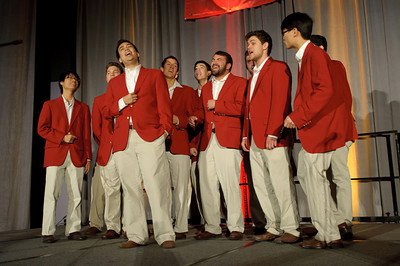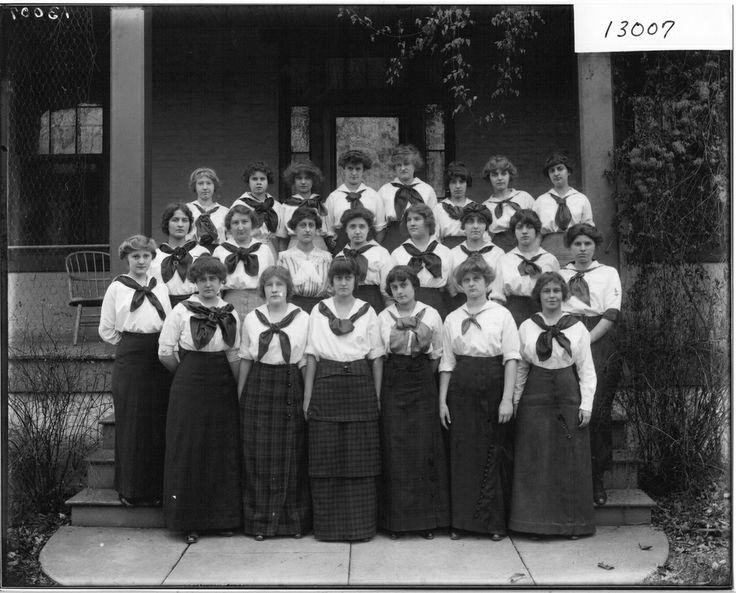I was an a cappella nerd in college. I should that add that at this point (i.e., back in the dark ages), there were few groups less cool than the a cappella nerds. I mean, we were less cool than the musical theater society. Really, really uncool. This is before Pitch Perfect, before the Sing-Off, before Glee, before American Idol (which granted is not a cappella but at least brought vocal performance front and center). And we were serious about our nerdity. We’d do a concert and them immediately go to the after-party and spend the entire night drinking rum and cokes and singing at the top of our lungs. (In fact, after a couple of these in a row, my sister refused to accompany me to any more parties on the grounds that they are incredibly boring for people who might like to talk or dance or do anything else but sing Journey songs.)
Now, collegiate a cappella has its own set of conventions. And of course those conventions were based on the origins of the art form, which in the case of collegiate a cappella involves a bunch men from a prestigious East Coast school standing in a line singing barbershop chords. If you’ve never experienced this, please enjoy the Yale Whiffenpoofs singing their signature closing number “The Whiffenpoof Song”, which they have been singing since 1909 (not kidding).
Of course things loosened up a bit between 1909 and when I joined the scene, but even so most groups still looked a lot like these guys.

(image source: Wikimedia Commons)
That’s the Stanford Mendicants. I’ve been to their alumni shows, so I can vouch that they’ve basically looked like that since the 70s.
When I started singing, it was widely accepted that mixed-gender groups (or heaven forbid, all-female groups) were just never going to be as good as all-male groups. Because I was an aca-nerd, I would be part of these discussions and hear things like “No offense, but male voices just blend together better”, and “No offense, but women’s voices just don’t have the purity of male sopranos”, and “Sorry, I just don’t like the sound of women’s voices – no offense”.
Now, these arguments are clearly sexist and stupid. In fact, just go listen to The Real Group as a palette cleanser from that nonsense.
But what’s interesting is the underlying assumption of what makes a group should look like. Because the gold standard of a cappella was defined as a group of 10-14 men standing in a line singing, that’s what all the groups strived to look like, even if that vision was (a) not possible because women and (b) not desirable because it didn’t fit the group’s strengths. I have some very embarrassing pictures of my mixed-gender group wearing neckties and collared shirts, because that’s how we thought groups were supposed to look. We did doo-wop choreography because that’s the way it was done. In retrospect it was totally absurd how strictly we adhered to these unspoken conventions, without even realized that’s what we were doing.
And lest you think I’m just talking about ancient history back in the 90s, please just take a look at the terribly-named acoUstiKats on The Sing-Off. Same preppy look we aspired for, same testosterone-fueled performance, bunch of yelling in the backgrounds, bouncy tenor up front (not to mention the offensive song choice). Feel free to turn it off after the first 8 bars, you’ll get the idea.
I was thinking about this recently because of a workshop run by a leader in women’s a cappella, Lisa Forkish, and the video I really wanted to share in this essay. Please go listen to this amazing cover of Dolly Parton’s Jolene, which she arranged for her group, The Riveters.
What I love about this arrangement, aside from the fact that it’s gorgeous, is that it has nothing to do with the conventions of “normal” a cappella. (Alert readers will note that this is not a collegiate group, but since most singers get their start in college groups, the performance and arranging conventions tend to carry over into the pro and semi-pro worlds.) For starters, there’s no bass line. The chords are beautifully arranged but it’s not done in the transcription SATB+solo style of collegiate groups. It’s a new sound. It’s theirs.
In her workshop, Lisa was talking about ways to grow women’s a cappella. And one of her main points was, take your space. Of course a performer has to take her space on the stage. But the part that really spoke to me was the point that to succeed you have to take your space creatively as well. Trying to re-make someone else’s art is never a path to excellence. And the problem for women in a cappella, as in so many other endeavors, is that the history was created mostly by men. And as in so many other fields, it’s easy to lose perspective and believe that the way things are done now is the way that things have to be done in the future.
So that is my lesson for the day. Take your space. Make something new. Don’t ask permission. And sing.
Featured image: Oxford College Glee Club, 1913
Image source: Miami University Archives

As I recall, some of these parties didn’t even have rum and coke and we had to drink Southern Comfort and Diet Coke, which was basically undrinkable even for me at 17. And, for the record, I told you at the time that the button-down shirt with suspenders and necktie was a bad look, especially for the women.